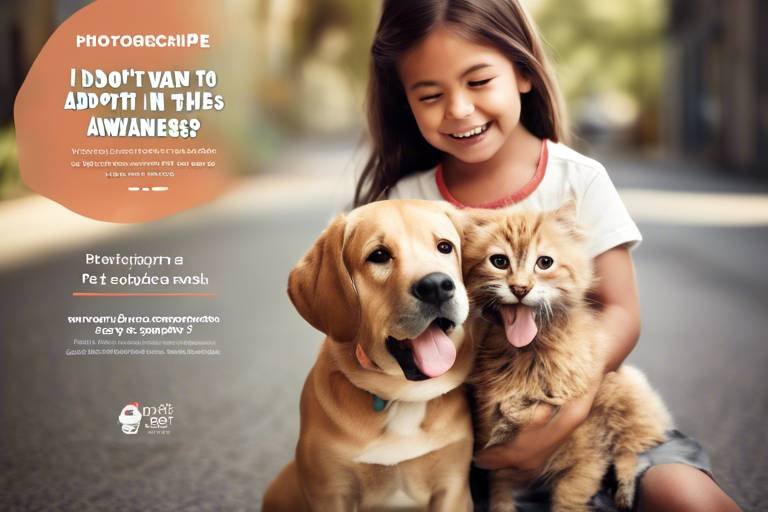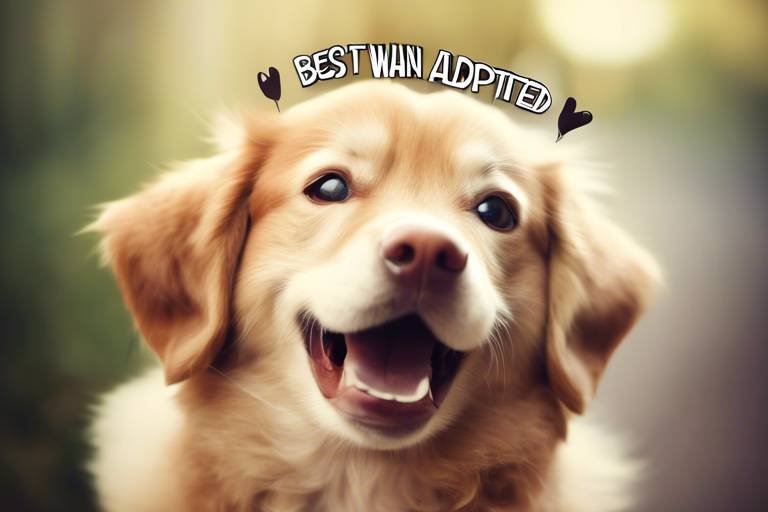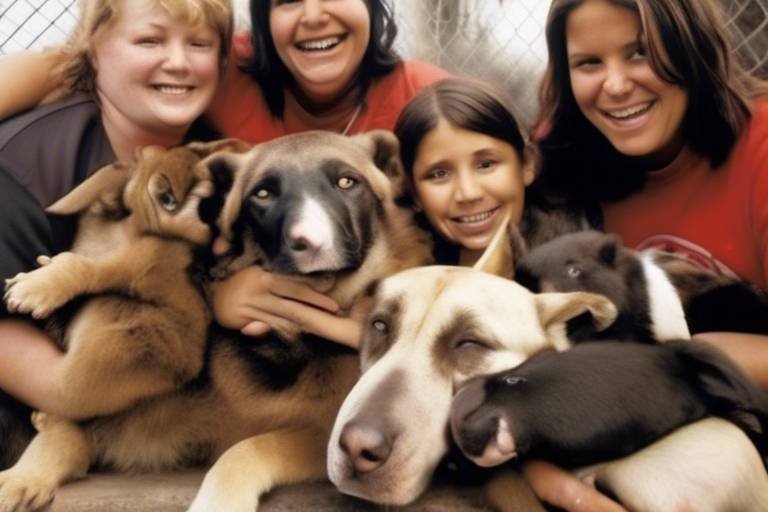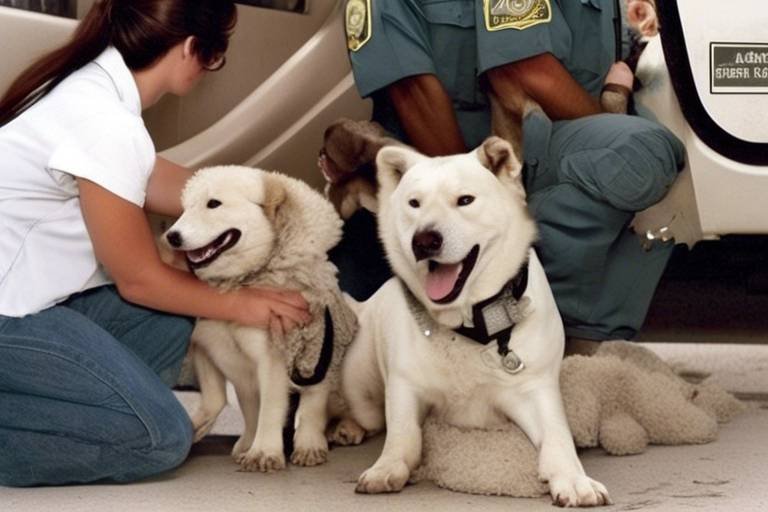How to Create a Pet Adoption Awareness Campaign
Launching a pet adoption awareness campaign is not just about finding homes for animals; it's about creating a movement that resonates with the community. Imagine walking through a park and seeing happy families with their adopted pets, or scrolling through social media and witnessing heartwarming stories of rescued animals finding their forever homes. This article explores effective strategies and ideas for launching a successful pet adoption awareness campaign, aimed at increasing community engagement and promoting the adoption of pets in need of homes.
Recognizing the importance of pet adoption is crucial for any campaign. Did you know that approximately 6.5 million companion animals enter U.S. animal shelters every year? This staggering statistic highlights the urgent need for awareness and action. Many of these animals are loving and loyal companions just waiting for a chance to be part of a family. By adopting, you not only save a life but also open up space in shelters for more animals in need. The benefits of adopting pets from shelters extend beyond just giving them a home; it also fosters a sense of community and responsibility among pet owners.
Establishing clear, measurable goals is essential for a successful campaign. Think of your campaign as a roadmap; without defined objectives, you might find yourself lost along the way. Start by asking yourself what you want to achieve. Is it increasing adoption rates by a certain percentage? Or perhaps raising awareness about the importance of spaying and neutering? Whatever your goals may be, make sure they are specific, measurable, achievable, relevant, and time-bound (SMART). For instance, a goal could be to increase pet adoptions by 20% within the next six months.
Knowing your audience helps tailor your message effectively. Are you targeting families, young professionals, or seniors? Each group may have different motivations for adopting a pet. Conduct surveys or focus groups to gather insights about potential adopters and supporters within the community. This understanding allows you to craft messages that resonate with them. For example, young professionals may be more interested in the companionship a pet can provide, while families might focus on the joy and responsibility of having a pet grow up with their children.
Effective messaging can inspire action. Imagine a slogan that pulls at your heartstrings or a story that makes you tear up. That’s the kind of impact you want to create! When crafting your messaging, think about the emotions you want to evoke. Use narratives that highlight the joy of adoption, such as success stories of pets who found loving homes. Don't shy away from using powerful visuals and emotional language. For instance, a message like “Every pet deserves a second chance” can resonate deeply with potential adopters.
Social media is a powerful tool for outreach. With billions of users worldwide, platforms like Facebook, Instagram, and Twitter can help you spread your message far and wide. Create engaging content that showcases adoptable pets, shares success stories, and promotes upcoming events. Use hashtags like #AdoptDontShop to reach a broader audience. Consider hosting live Q&A sessions where potential adopters can ask questions about pet ownership and adoption. Remember, the more interactive your content, the more likely it is to engage your audience!
Community events can significantly boost visibility. Think about hosting adoption fairs, where people can meet pets in need of homes, or educational workshops that teach responsible pet ownership. These events not only promote adoption but also foster a sense of community. You could even organize fun activities like pet parades or photo contests, encouraging people to share their experiences with adopted pets. The more fun and engaging your events are, the more likely people will participate and spread the word.
Partnerships can enhance your campaign's reach. Local businesses often want to give back to the community, and collaborating with them can create mutually beneficial initiatives. For example, a pet store might sponsor an adoption event, or a local café could host a “Pet Adoption Day” where a portion of sales goes to supporting your campaign. These partnerships not only provide resources but also help in spreading the message to a wider audience. Remember, it’s all about building relationships that benefit both parties and the pets in need.
Evaluating the effectiveness of your campaign is vital. How do you know if your efforts are making a difference? Establish methods for tracking progress, such as monitoring adoption rates, social media engagement, and event attendance. Tools like Google Analytics can help you understand your online impact. Set benchmarks and review them regularly to see what’s working and what needs adjustment. This way, you can refine your approach and ensure your campaign is as effective as possible.
- What is the best way to promote a pet adoption event? Utilize social media, local news outlets, and flyers in community centers.
- How can I encourage more people to adopt pets? Share success stories, provide educational resources, and create engaging campaigns that highlight the joys of pet ownership.
- What are some effective fundraising ideas for pet adoption campaigns? Consider hosting bake sales, auctions, or online crowdfunding campaigns to support your initiatives.

Understanding the Need for Pet Adoption
When we think about our furry friends, it’s hard to imagine a world where they don’t have loving homes. However, the reality is that millions of pets are waiting in shelters, hoping for a second chance at life. According to recent statistics, approximately 6.5 million companion animals enter U.S. animal shelters every year. This staggering number highlights the urgent need for pet adoption campaigns that can connect these animals with caring families.
But why is pet adoption so important? For starters, adopting a pet not only saves a life but also helps reduce the number of animals in shelters. Every time someone chooses to adopt, they effectively make room for another animal in need. The cycle of abandonment and overpopulation can be daunting, but your decision to adopt can be a powerful step toward change. Moreover, adopting pets from shelters often comes with a host of benefits:
- Cost-Effectiveness: Adoption fees are typically much lower than purchasing a pet from a breeder or pet store, and many shelters include vaccinations and spaying/neutering in the fee.
- Health Check: Most shelter animals are evaluated for health issues, ensuring that you are adopting a pet that has been cared for and is ready for a new home.
- Variety of Choices: Shelters often have a diverse range of animals, from puppies and kittens to older pets who are just as loving and deserving of a home.
Additionally, adopting pets contributes to the overall well-being of our communities. Pets can be incredible companions, offering unconditional love and support. They encourage physical activity, reduce stress, and can even improve mental health. The bond between humans and animals is profound, and adopting a pet can transform not only their life but yours as well.
Furthermore, pet adoption campaigns can spark community engagement. By raising awareness about the need for adoption, we can inspire others to join the cause, creating a ripple effect that leads to more adoptions and less suffering for animals. It’s not just about finding homes; it’s about building a community that cares for its most vulnerable members.
In conclusion, understanding the need for pet adoption is the first step in creating a successful campaign. By recognizing the statistics and the emotional benefits of adopting a pet, we can work together to ensure that every animal finds a loving home. The journey of a pet from shelter to forever home is a beautiful story waiting to be told, and you can be a part of it. So, let’s roll up our sleeves and make a difference, one paw at a time!

Setting Campaign Goals
When it comes to launching a successful pet adoption awareness campaign, setting clear and measurable goals is like having a roadmap for a long journey. Without defined objectives, you might find yourself wandering aimlessly, unsure of your direction. So, how do you go about establishing these goals? First, consider what you want to achieve with your campaign. Are you aiming to increase the number of pets adopted from local shelters, raise awareness about pet homelessness, or perhaps educate the community on responsible pet ownership? Each of these objectives can guide your campaign's strategy and messaging.
Next, it's crucial to make your goals SMART—Specific, Measurable, Achievable, Relevant, and Time-bound. For instance, instead of saying, "We want to help pets find homes," you might say, "We aim to increase pet adoptions by 25% over the next six months." This specific goal not only gives you a clear target but also allows you to measure your progress effectively.
Additionally, breaking down your larger goals into smaller, actionable steps can make the process less overwhelming. Consider creating a timeline that outlines key milestones you want to reach throughout your campaign. This could look something like:
| Milestone | Target Date | Actions Required |
|---|---|---|
| Launch Campaign | Month 1 | Finalize messaging and materials |
| First Community Event | Month 2 | Organize an adoption fair |
| Mid-Campaign Review | Month 3 | Assess progress and adjust strategies |
| Final Adoption Drive | Month 6 | Host a large adoption event |
By keeping your goals organized and visible, you can maintain focus and motivation throughout your campaign. Remember, it’s not just about the numbers; it’s about the lives you’re impacting. Each pet adopted is a success story waiting to happen, and with the right goals in place, you can create a ripple effect of positive change in your community.
Lastly, don’t forget to involve your team and stakeholders in the goal-setting process. This collaborative approach not only fosters a sense of ownership but also brings diverse perspectives that can enhance your campaign’s effectiveness. After all, many hands make light work, and when everyone is on the same page, you’ll find that achieving your goals becomes a shared mission.
- What are the most common goals for pet adoption campaigns? Common goals include increasing adoption rates, raising awareness about pet homelessness, and educating the public on responsible pet ownership.
- How can I measure the success of my campaign? You can track metrics such as the number of pets adopted, social media engagement, event attendance, and surveys to gauge community awareness.
- Is it important to set a timeline for my campaign goals? Yes, having a timeline helps keep your campaign organized and ensures that you stay on track to meet your objectives.

Identifying Your Target Audience
When it comes to launching a successful pet adoption awareness campaign, one of the most crucial steps is . Think of your campaign as a beautiful puzzle; each piece represents a different segment of the community that you want to engage with. If you don’t know which pieces fit where, the picture will never come together. So, how do you figure out who your audience is? Well, it all starts with understanding the demographics and psychographics of your community.
First and foremost, consider the demographics. This includes age, gender, income level, and family status. For instance, young families might be more inclined to adopt pets, especially if they have children who are eager for a furry companion. On the other hand, single professionals might be looking for a pet that fits into their busy lifestyle. By gathering this information, you can tailor your messaging to resonate with different groups. Here’s a quick look at some potential demographics you might want to focus on:
| Demographic Group | Potential Interests |
|---|---|
| Young Families | Family-friendly pets, educational resources |
| Single Professionals | Low-maintenance pets, companionship |
| Retirees | Companionship, emotional support |
| Students | Affordable pet options, social media engagement |
Next, let’s dive into the psychographics. This is where it gets interesting! Psychographics involve the attitudes, values, and lifestyles of your audience. Are they animal lovers who already have pets? Do they value adoption over buying from breeders? Understanding these factors can help you craft messages that resonate deeply with your audience. For example, if your target audience values sustainability and animal welfare, you can highlight the positive impact of adopting a pet from a shelter.
Another effective strategy is to engage with your community through surveys or social media polls. Ask questions like, “What do you look for in a pet?” or “What would encourage you to adopt?” This not only helps you gather valuable insights but also makes your audience feel involved in the process. After all, who doesn’t love to share their opinions?
Don’t forget about the importance of community engagement. Attend local events, visit schools, or partner with community organizations to get a feel for who your potential adopters are. By being present and actively listening to the community, you can gain insights that data alone may not provide. It’s all about building relationships and trust. Remember, people are more likely to adopt if they feel a personal connection to the cause.
Lastly, consider segmenting your audience into different categories based on their interests and behaviors. This way, you can create targeted campaigns that speak directly to each group. For instance, if you identify a group of college students who are interested in adopting pets, you might focus on the benefits of having a pet for emotional support during stressful exam periods.
In conclusion, identifying your target audience is not just about gathering data; it’s about understanding the heart and soul of your community. By knowing who you’re speaking to, you can create a campaign that truly resonates and inspires action. So, roll up your sleeves, get out there, and start connecting with your future adopters!
- How can I gather demographic information about my community? You can use surveys, social media analytics, or collaborate with local organizations that may have data available.
- What are some effective ways to engage with my audience? Attend local events, host workshops, and utilize social media to create interactive content.
- Is it important to focus on psychographics? Yes! Understanding your audience's values and lifestyles can significantly enhance your messaging and outreach efforts.

Creating Compelling Messaging
When it comes to launching a successful pet adoption awareness campaign, is absolutely essential. Think of your messaging as the heart of your campaign—it needs to beat strongly and resonate with your audience to inspire action. But how do you craft messages that truly connect? It starts with understanding the emotional pull of pet adoption. After all, adopting a pet is not just about giving an animal a home; it’s about gaining a loyal companion who will bring joy and love into your life.
One effective way to create compelling messaging is to tell stories. People love stories, especially those that tug at the heartstrings. Share the journey of a pet from the shelter to a loving home. Use vivid imagery and emotional language to paint a picture. For instance, instead of saying, “Adopt a dog,” you could say, “Imagine coming home to a wagging tail and a furry friend who can’t wait to see you.” This approach not only captures attention but also makes the idea of adoption feel personal and relatable.
Another crucial element is to highlight the benefits of adoption. Many potential adopters may not realize the incredible advantages that come with adopting a pet from a shelter. Here are a few key points to emphasize:
- Saving a Life: Every adoption means one less animal in need, and it contributes to reducing the overall number of homeless pets.
- Cost-Effective: Adopting from a shelter is often less expensive than buying a pet from a breeder, and many shelters include vaccinations and spaying/neutering as part of the adoption fee.
- Unconditional Love: Pets adopted from shelters often have an immense capacity for love and gratitude, making them incredibly rewarding companions.
In addition to storytelling and highlighting benefits, it's important to create a catchy slogan that encapsulates your message. A memorable slogan can stick in people's minds and encourage them to take action. Think about slogans like “Adopt, Don’t Shop” or “Find Your Furry Forever Friend.” These phrases are not only catchy but also convey a powerful message about the importance of adoption.
Don’t forget about the visuals! A picture is worth a thousand words, especially when it comes to pets. Use high-quality images of adorable animals looking for homes. Consider creating infographics that illustrate the impact of pet adoption, such as statistics on the number of animals in shelters versus those adopted. Visual content can enhance your messaging and make it more shareable on social media platforms.
Finally, be sure to include a clear call to action in your messaging. Whether it’s “Visit your local shelter today!” or “Join us for our adoption event this weekend!”—make it easy for your audience to know what steps to take next. The more straightforward your call to action, the more likely people are to respond.
In summary, creating compelling messaging for your pet adoption awareness campaign involves a blend of storytelling, highlighting benefits, catchy slogans, engaging visuals, and clear calls to action. By weaving these elements together, you can craft messages that not only inform but also inspire your community to take action and give pets the loving homes they deserve.
Q1: How can I make my messaging more relatable?
A1: Use personal stories and real-life examples that potential adopters can connect with. Share testimonials from happy adopters and their pets.
Q2: What platforms should I use to share my messaging?
A2: Utilize social media platforms like Facebook, Instagram, and Twitter, as well as local community boards and newsletters to reach a broader audience.
Q3: How often should I update my messaging?
A3: Regular updates are crucial, especially when you have new pets available for adoption or upcoming events. Keep your content fresh and engaging!

Utilizing Social Media Platforms
In today’s digital age, social media platforms have become one of the most powerful tools for spreading awareness and engaging communities. Imagine a world where every pet waiting for a loving home has a voice, and that voice is amplified through the likes of Facebook, Instagram, and Twitter. These platforms are not just for sharing cute cat videos or dog memes; they can serve as the backbone of your pet adoption awareness campaign. But how do you effectively harness the power of social media?
First and foremost, it's essential to identify which platforms your target audience frequents the most. For instance, if you’re aiming to connect with younger adopters, platforms like Instagram and TikTok might be your best bet. On the other hand, if you're looking to engage with a more mature audience, Facebook could be your golden ticket. By understanding where your audience hangs out online, you can tailor your content to fit their preferences and habits.
Next, the type of content you create is crucial. Visual content, such as photos and videos of adorable pets, tends to garner more attention and engagement than text-based posts. Consider creating heartwarming videos that showcase pets' personalities, their stories, and their journey to finding a forever home. You could even feature testimonials from happy adopters to inspire others to take the leap. Remember, a picture is worth a thousand words, and a video can be worth even more!
Engagement is another key factor. Don’t just post and ghost! Make sure to interact with your followers. Respond to comments, ask questions, and encourage them to share their own pet adoption stories. You might consider hosting a weekly Q&A session where potential adopters can ask questions about the adoption process, or even a “Pet of the Week” feature that highlights a specific animal in need of a home. This not only creates a sense of community but also keeps your audience engaged and invested in your cause.
Moreover, utilizing hashtags can significantly enhance your campaign’s visibility. Think of relevant hashtags like #AdoptDontShop, #RescuePets, and #PetAdoptionAwareness. These can help your posts reach a broader audience who are already interested in pet adoption. You can even create a unique hashtag for your campaign to track engagement and encourage others to use it when sharing their own adoption stories.
Lastly, don’t underestimate the power of partnerships with local influencers or pet bloggers. Collaborating with individuals who have a strong following can help amplify your message. They can share your posts, attend your events, or even help create content that highlights the importance of pet adoption. This kind of grassroots marketing can make a significant impact on your campaign’s success.
In conclusion, utilizing social media platforms effectively can transform your pet adoption awareness campaign from a simple initiative into a vibrant community movement. By understanding your audience, creating engaging content, fostering interaction, leveraging hashtags, and collaborating with influencers, you can spread the word about the joys of pet adoption far and wide. So, are you ready to take the plunge and make a difference for pets in need?
- How can I measure the success of my social media campaign? You can track engagement metrics such as likes, shares, comments, and the number of new followers gained during the campaign.
- What type of content works best for pet adoption campaigns? Visual content like photos and videos of pets, along with heartwarming stories and testimonials, tends to perform well.
- How often should I post on social media? Consistency is key; aim for at least a few posts per week to keep your audience engaged without overwhelming them.

Organizing Community Events
When it comes to raising awareness about pet adoption, organizing community events can be a game changer. Imagine a vibrant gathering where pet lovers unite, each person buzzing with excitement and compassion for animals in need. These events not only create a platform for potential adopters to meet their furry friends but also foster a sense of community around a shared cause. One of the most effective ways to engage people is by hosting adoption fairs, where local shelters bring pets looking for homes. Picture this: families strolling through booths filled with adorable pets, each one hoping to find their perfect match. It’s like a matchmaking service, but for pets!
However, it’s not just about the pets; it’s also about education. Workshops that teach responsible pet ownership can empower attendees with knowledge on how to care for their new companions. You could invite local veterinarians to discuss health care, nutrition, and training tips. This not only enriches the experience for potential adopters but also positions your campaign as a valuable resource in the community. Think of it as building a bridge between the shelters and the community, where everyone benefits.
Another exciting idea is to host themed events that resonate with the community’s interests. For instance, a “Paws and Paint” day could allow families to create art with their pets while learning about adoption. This unique blend of creativity and compassion can draw in a diverse crowd, making it an unforgettable day. You could even have local artists showcase their work, with a portion of the sales going to support local shelters. It’s a win-win!
Don't forget about the power of partnerships! Collaborating with local businesses can amplify your event's reach. Imagine a local café providing snacks for attendees, or a pet supply store sponsoring giveaways. These partnerships not only enhance the event but also create a sense of community involvement. It’s like throwing a party where everyone contributes to the fun and purpose.
To ensure your community events are a success, consider the following:
- Promote Early: Use social media, flyers, and community boards to get the word out well in advance.
- Engage Volunteers: Rally local volunteers to help with planning and execution. Their enthusiasm can be infectious!
- Follow Up: After the event, reach out to attendees to thank them for their participation and encourage them to consider adoption.
In conclusion, organizing community events is not just about fun and games; it’s about creating lasting connections between animals in need and loving homes. By crafting unique experiences that educate and entertain, you can significantly boost awareness for pet adoption and inspire more people to open their hearts and homes to pets in need. So, roll up your sleeves, gather your team, and start planning an event that your community will remember!

Collaborating with Local Businesses
When it comes to creating a successful pet adoption awareness campaign, can be a game-changer. Imagine walking into your favorite coffee shop and seeing a poster of adorable pets available for adoption. Or perhaps, you’re at a local pet store and there’s a special event featuring pets from the nearby shelter. These partnerships not only enhance visibility but also foster a sense of community, bringing together animal lovers and potential adopters in a way that feels organic and engaging.
Local businesses are often eager to support community initiatives, especially those that resonate with their customers. By reaching out to them, you can create mutually beneficial relationships that promote pet adoption while also driving traffic to their establishments. For instance, a local bakery might agree to donate a portion of their sales on a specific day to your cause, or a pet grooming service might offer discounts to new pet adopters. It’s a win-win situation: the business gains positive publicity and increased customer loyalty, while your campaign benefits from heightened awareness and funding.
To kickstart these collaborations, consider the following strategies:
- Identify Potential Partners: Look for businesses that align with your mission. Pet stores, veterinary clinics, and even cafes can be great options.
- Propose Creative Ideas: Think outside the box! You could suggest hosting adoption events at their locations, offering pet-themed workshops, or even running a social media contest together.
- Highlight Benefits: Clearly outline how the collaboration will benefit the business. Whether it’s increased foot traffic or positive community engagement, make sure they see the value in partnering with you.
Once you’ve established partnerships, it’s crucial to maintain open communication and regularly update your collaborators on the progress of your campaign. Sharing success stories, such as pets that have found loving homes through the initiative, can keep the enthusiasm alive and encourage ongoing support. This kind of collaboration creates a ripple effect in the community, inspiring others to get involved and spread the word about the importance of pet adoption.
In conclusion, collaborating with local businesses not only amplifies your pet adoption awareness campaign but also strengthens community bonds. By working together, you can create a powerful network of support that drives change and helps countless animals find their forever homes.
Q: How can I approach local businesses for collaboration?
A: Start by identifying businesses that share your values. Prepare a proposal that outlines the benefits of collaboration, and reach out via email or in person to discuss potential ideas.
Q: What types of events can I organize with local businesses?
A: You can host adoption fairs, pet-friendly events, workshops, or even fundraising activities where a portion of sales goes towards your campaign.
Q: How can I measure the success of these collaborations?
A: Track metrics such as the number of adoptions resulting from events, social media engagement, and any increase in foot traffic for the businesses involved.

Measuring Campaign Success
When it comes to running a pet adoption awareness campaign, one of the most crucial aspects is understanding how to measure its success. After all, what’s the point of all the hard work if you can’t see the results? To truly grasp the impact of your efforts, you’ll need to establish clear metrics that reflect your campaign's effectiveness. Think of these metrics as your campaign's heartbeat; they will tell you whether your initiatives are resonating with the community or if adjustments are needed.
First and foremost, setting up a baseline measurement before launching your campaign is essential. This could involve tracking the number of adoptions at local shelters, community engagement levels, or social media interactions. By having these figures on hand, you can compare them to your post-campaign data to see how far you've come. For instance, if your shelter was facilitating 20 adoptions a month before the campaign, and you find that number has increased to 50 after your efforts, that’s a clear sign of success!
Another effective way to measure success is through surveys and feedback forms. These can be distributed to new pet adopters and event participants to gauge their awareness of your campaign and how they heard about it. Questions might include:
- How did you learn about our pet adoption campaign?
- What motivated you to adopt a pet?
- On a scale of 1-10, how likely are you to recommend our campaign to others?
This feedback is invaluable, as it not only shows you what’s working but also highlights areas for improvement. Additionally, consider tracking the engagement metrics on your social media platforms. Are people liking, sharing, and commenting on your posts? High engagement rates can indicate that your message is resonating with your audience.
Moreover, you can analyze the traffic to your website or social media pages during the campaign period. Tools like Google Analytics can provide insights into how many visitors you received, where they came from, and what actions they took on your site. If you see a spike in traffic coinciding with your campaign, that’s a good indication that your outreach efforts are paying off.
It's also wise to keep an eye on the number of partnerships you establish with local businesses and organizations. Successful collaborations can amplify your message and reach a broader audience. Track how many businesses joined your cause and what kind of promotional efforts they contributed. This not only enhances your campaign but also builds a sense of community around pet adoption.
Finally, don’t forget to celebrate your wins, no matter how small. Each adoption story, each community member who learns about the importance of adopting pets, is a step in the right direction. After the campaign concludes, compile your findings into a comprehensive report. This document can serve as a roadmap for future campaigns, helping you understand what worked, what didn’t, and how you can improve moving forward.
In summary, measuring the success of your pet adoption awareness campaign involves a mix of quantitative and qualitative data. By establishing clear metrics, gathering feedback, and analyzing engagement, you can gain a comprehensive understanding of your campaign's effectiveness. Remember, the ultimate goal is not just to increase adoption rates but to foster a community that values and supports animal welfare.
Q: How can I effectively measure community engagement during my campaign?
A: You can measure community engagement by tracking social media interactions, attendance at events, and feedback from surveys. This will help you understand how well your message resonates with the audience.
Q: What tools can I use to analyze the success of my campaign?
A: Tools like Google Analytics for website traffic, social media analytics for engagement metrics, and survey platforms for feedback collection can provide valuable insights into your campaign's performance.
Q: How often should I evaluate my campaign's success?
A: It's beneficial to evaluate your campaign at multiple intervals—before, during, and after—to make timely adjustments and accurately measure overall success.
Frequently Asked Questions
- Why is pet adoption important?
Pet adoption is crucial because it helps reduce the number of homeless animals in shelters. By adopting, you’re not just giving a pet a loving home, but you're also making space for another animal in need. Plus, adopting pets can lead to a happier life for both you and your new furry friend!
- What are some common misconceptions about adopting pets?
Many people think that shelter pets are problematic or have behavioral issues. However, most pets in shelters are simply victims of circumstance. They are often loving, well-adjusted animals looking for a second chance. Adopting a pet from a shelter can be one of the most rewarding experiences!
- How can I set effective goals for my pet adoption campaign?
Start by defining what you want to achieve. Are you looking to increase adoptions by a certain percentage, or perhaps raise awareness about pet homelessness? Make your goals specific, measurable, achievable, relevant, and time-bound (SMART). This clarity will guide your campaign and help track progress.
- Who should I target in my pet adoption campaign?
Your target audience could include potential pet adopters, local businesses, and community members who are passionate about animal welfare. Tailor your messaging to resonate with different segments, like families looking for pets, young adults wanting companions, or seniors seeking companionship.
- What types of messaging work best for promoting pet adoption?
Compelling and heartfelt stories about pets can tug at the heartstrings. Use narratives that highlight the joy and companionship pets bring into our lives. Catchy slogans and emotional visuals can also help make your message more memorable and impactful!
- How can social media be utilized for a pet adoption campaign?
Social media platforms are fantastic for spreading awareness! You can share success stories, post adorable photos of pets available for adoption, and create engaging content like polls or quizzes. Don’t forget to use relevant hashtags to reach a wider audience!
- What community events can I organize to promote pet adoption?
Consider hosting adoption fairs, pet meet-and-greets, or educational workshops. These events not only showcase available pets but also educate the community about the importance of adoption. Partnering with local veterinarians or pet stores can also increase your event’s visibility!
- How can local businesses help in my pet adoption campaign?
Local businesses can play a significant role by sponsoring events, donating supplies, or even offering discounts for adopters. Collaborating with them can create a win-win situation where businesses gain community goodwill while promoting pet adoption!
- How do I measure the success of my pet adoption campaign?
Track metrics such as the number of adoptions, social media engagement, and attendance at events. Surveys can also be useful in understanding community awareness before and after your campaign. Analyzing this data will help you refine future campaigns for even greater impact!



















